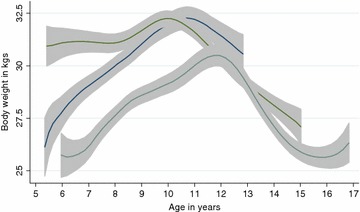Fig. 2.

Polynomial smooth plots of average body weight (lines) with 95% confidence intervals (CI, gray shaded areas) by age for each longevity group of dogs. The starting point for each line is the average body weight for those dogs which were in the acclimatisation period at that age on 01 July 2004 just before the study started. The end point for each line is the average body weight for those dogs which died or were censored (N = 5 in the Exceptional group) at that age at the censor date of 31 July 2014. These plots show that the Expected dogs (blue line) started at a low weight, then put on about 1 kg/year until reaching a peak at 11 years of age and this was followed by a decline of ~1.7 kg in 2 years. The Long-lived dogs (green line) started at a higher weight, then stayed at a rather stable weight before showing an increased weight over to reach a peak at 10 years of age and then the weight declined at ~1 kg/year. The Exceptionally long-lived dogs (gray) started at the lowest weight (but at an older age) and they put on weight gradually to reach a peak at 12 years of age, then slowly declined to reach a low point at 16 years before putting on some weight again
